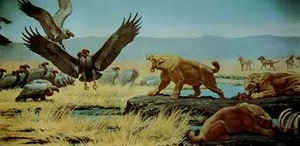Wyoming State Fossil
Knightia (Fish)

(Knightia eocaena)
Adopted on February 18, 1987
Wyoming adopted two official fishes in 1987. The cutthroat trout, the only trout native to Wyoming, was designated the state fish. Knightia, (Knightia eocaena,) a prehistoric herring that left countless fossils in Wyoming, was named the state fossil. Prehistoric type of herring, closely related to today's Clupea herrings - lived 50 million years ago in a freshwater lake in what is now southwestern Wyoming. Their demise is a bit of a mystery; all we really know is that they died very suddenly, in large groups.
Wyoming State Fossil: Knightia (Fish)

Poisonous volcanic gases, temperature fluctuations, food supply shortages, and algal blooms are conditions which have been known to kill modern fish populations. Thus scientists speculate that one or more of these circumstances may have contributed to Knightia's abrupt passing
A super site is the Green River Formation in Wyoming, the 50 million year old home of several species of fossil fish, including the state fossil of Wyoming, Knightia.
50 million years ago the area that we now call Green River, Wyoming was a series of basin-filled lakes that developed in the eastern Rocky Mountains after an intense period of tectonic movements. These lakes were fed by rapidly flowing rivers, and were the home of several amazing varieties of fish, including the herring-like creature Knightia. The first Knightia fossils were discovered in the 1840's, when missionaries and explorers traveling through the American West opened up Wyoming for settlement. After the first Knightia fossils were collected they were called to the attention of the University of Wyoming. There the genus was christened Knightia, after Wilbur Clinton Knight, the first Wyoming state geologist.

In life the genus Knightia likely grew to a length of 5-10 inches and was covered by layers of scales, similar to those seen in modern day fish. Knightia had a relatively large head covered with protective plates and its vertebral column was nearer to its back than its stomach, like humans. Like several modern freshwater fish it had four fins, ones on its back, stomach, pelvis, and anus. Knighta's diet likely consisted of plankton and algae, fossils of which have also been found in the Green River formation. In turn, Knightia was probably eaten by larger fish and crocodiles, possibly even the boa constrictors which have been found fossilized alongside Knightia in Wyoming
Wyoming Law
The law designating the fossilized fish Knightia as the official Wyoming state fossil is found in the Wyoming Statutes, Title 8, Chapter 3, Section 8-3-112.
Title 8 General Provisions
Chapter 3 State Seal, Flag, Flower, Bird and Other Symbols
Wyo. Stat. § 8-3-112 (2013)
§ 8-3-112. State fossil.
The fossilized fish Knightia is the state fossil of Wyoming.
HISTORY: Laws 1987, ch. 19, § 1
Taxonomic Hierarchy: Knightia
Kingdom: AnimaliaPhylum: Chordata
Class: Actinopterygii
Order: Clupeiformes
Family: Clupeidae
Subfamily: Pellonulinae
Genus: Knightia - Jordan 1907
Type species
Knightia eocaena - Jordan, 1907
Species
K. alta - (Leidy, 1873)
K. branneri
K. eocaena Jordan 1907
K. humulus
K. irregularis Longstaff, 1933
K. vetusta Grande, 1982
Synonyms
Clupea alta - (Leidy, 1873)
Clupea eocaena Jordan, 1907

Some states that lack a "state fossil" have nevertheless singled out a fossil for formal designation such as a state dinosaur, rock, gem or stone.







